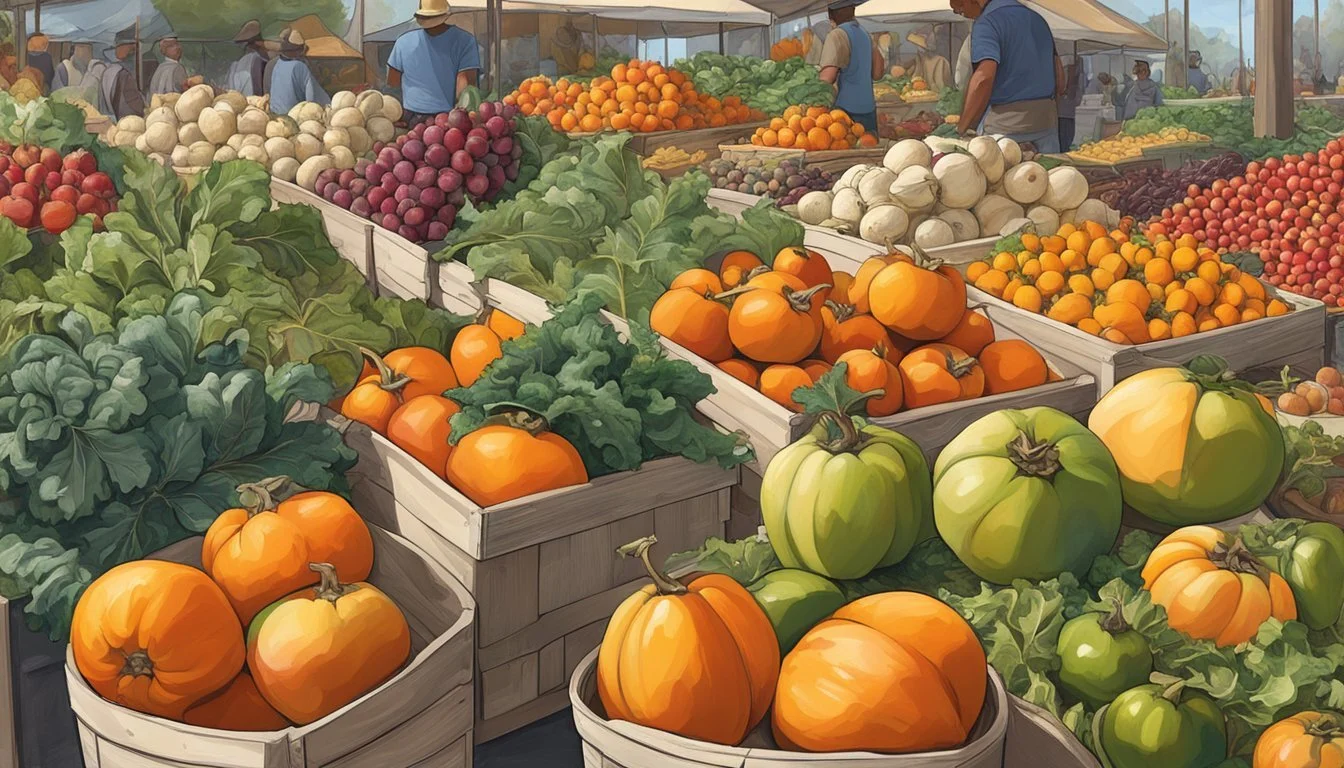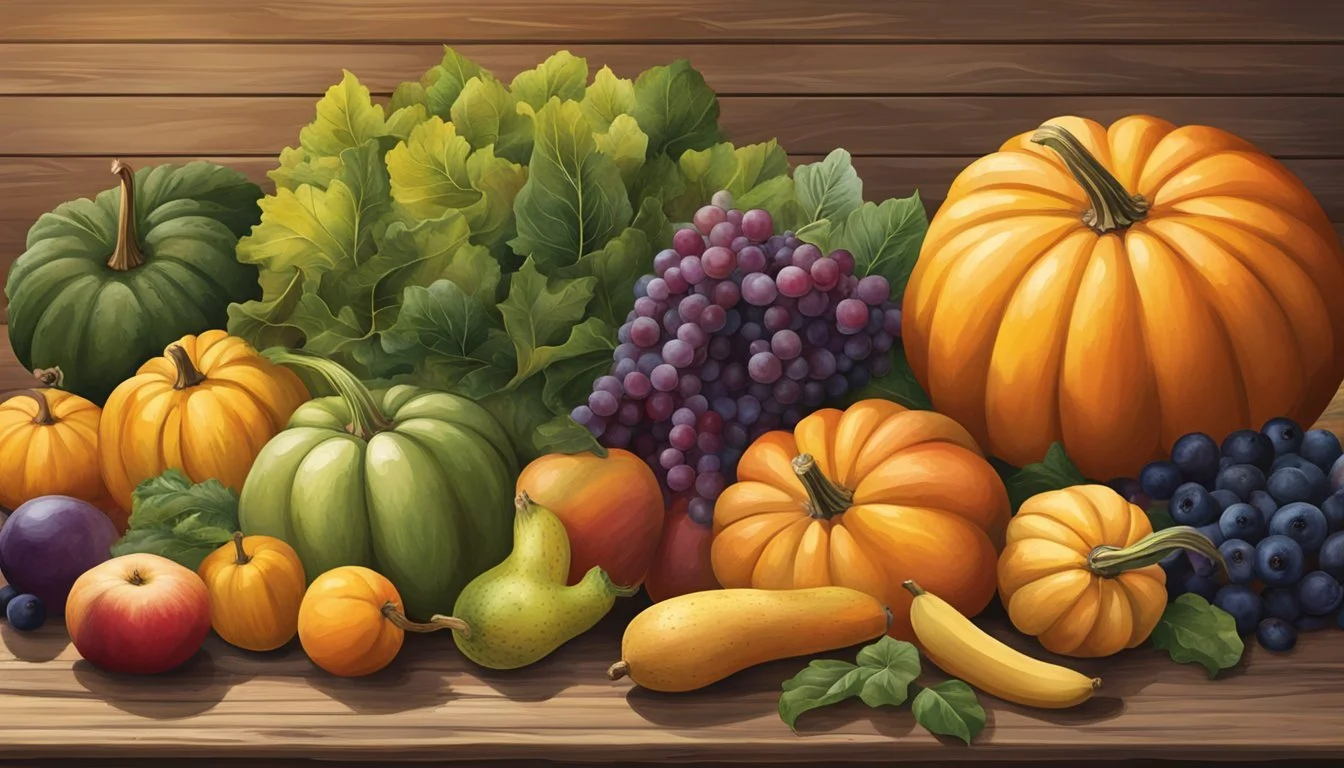California Seasonal Fruit & Vegetables in November
A Guide to the Freshest Produce
This Article is Part of our California Seasonal Fruit & Veg Calendar
California's diverse climate yields a rich variety of fruits (What wine goes well with fruits?) and vegetables throughout the year. November marks the transition from the golden state's warm harvests to the crisper offerings of the cooler season. Among the standout seasonal produce, tangelos become a notable option, offering a unique citrus flavor during this period. They are not the only fruits to look for; apples also have a moment, capturing the essence of fall with their crispness and sweetness.
In the vegetable aisles, November brings forward a selection of robust flavors. Consumers can find a bounty of leafy greens which thrive in the cooler temperatures. Root vegetables like beets (how long do beets last?) and carrots (how long do carrots last?) are also at their best, having developed their full flavor profile. Californian farmers markets and grocery stores during this month become a showcase for these seasonal offerings.
Understanding and shopping for seasonal produce in California during November allows for not only an experience of peak flavors but also supports local agriculture and sustainability. This alignment with the natural growing seasons ensures that the fruits and vegetables are at their optimal taste and nutritional value while minimizing the environmental impact of long-distance transportation.
Understanding California's Seasonal Produce
California's diverse climate allows for year-round agricultural productivity. November marks a period where the state's produce availability transitions reflecting the seasonal shift into winter.
The Role of Seasons in Produce Availability
California experiences a broad range of climates, from Mediterranean to subarctic, profoundly affecting the variety and availability of produce throughout its vast agricultural regions. In November, consumers can expect a shift as winter approaches, with many summer fruits and vegetables phasing out and cool-weather crops becoming more prominent.
In this season, the state's produce includes:
Fruits:
Persimmons: Bright, sweet, and typically harvested in the fall.
Pomegranates: Known for their jewel-like seeds, available in autumn and early winter.
Kiwi: This tangy fruit often ripens by late fall.
Vegetables:
Winter Squash: Varieties like butternut remain in season.
Leafy Greens: Kale and chard thrive in cooler temperatures.
Root Vegetables: Beets and carrots are harvested into winter.
Residents and chefs alike lean on this seasonal shift to inform their culinary choices, showcasing the best produce the state of California has to offer in November. It is an opportunity to experience the culmination of fall harvests and the beginning of winter offerings.
November's Harvest
November marks the transition into California's cooler season, yet it remains a bountiful month for harvest. This period showcases a variety of fruits and vegetables, each with their optimal freshness and flavor.
Fruits to Enjoy
Persimmons: They come into their prime in November, offering a sweet, honeyed flavor.
Pomegranates: Known for their jewel-like seeds, pomegranates are at peak ripeness.
Kiwi: The fuzzy fruit typically begins its season this month, introducing a tart freshness.
Oranges: Citrus season starts to flourish, with oranges adding a burst of vitamin C to the cooler days.
Vegetable Bounty
November is not only about fruit; vegetables also continue to thrive:
Cruciferous Vegetables: Broccoli and cauliflower are in abundance, perfect for hearty dishes.
Leafy Greens: Kale, spinach, and chard grow well during the cooler temperatures and are ready for harvest.
Root Vegetables: Carrots and beets, with their earthy sweetness, are pulled from the ground with vibrant color and full of nutrients.
Seasonal Fruits Detailed
In November, California's abundance of seasonal fruits shifts to feature an array of citrus and late fall varieties, while some berries and exotic selections make a limited appearance. This fascinating mix offers both vibrant flavors and health benefits.
Citrus Galore
California's citrus fruits truly shine in November. The harvest includes a variety of oranges such as Navel and Valencia, known for their sweet, juicy segments. Mandarins come into season, offering a convenient, easy-to-peel snack. Among the most notable are the Satsuma and Clementine varieties, which are seedless and exceptionally sweet. Tangelos, a tangy cross between tangerines and grapefruit, are at their peak, combining the best flavors of both parents.
Oranges: Navel, Valencia
Mandarins: Satsuma, Clementine
Tangelos: Minneola, Orlando
Late Fall Varieties
As fall deepens, fruits that thrive in the cooler months begin to emerge. Pomegranates burst onto the scene with their jewel-like arils, packing a tart punch and antioxidant power. Persimmons, with their honey-like taste, especially the Fuyu and Hachiya varieties, are perfect for baking or eating raw. Kiwi also makes its entry, providing a fresh, tart flavor and vitamin C boost.
Pomegranates: Wonderful, Angel Red
Persimmons: Fuyu, Hachiya
Kiwi: Hayward
Berries and Exotic Selections
Berries, while not as prevalent as in the summer months, can still be found. Look for late-harvest strawberries or greenhouse-grown varieties maintaining that pop of sweetness. On the exotic side, passion fruit might be encountered, offering a tropical burst to the palate. Nuts such as almonds and walnuts are also harvested, rounding out the month's bounty with their rich, savory crunch.
Strawberries: Seascape, Albion
Exotic Selections: Passion Fruit
Nuts: Almonds, Walnuts
In November, these fruits provide not only a seasonal exploration of California's agricultural variety but also the opportunity to enjoy fresh, flavorful produce at its peak.
Seasonal Vegetables Detailed
November marks a transitional period in California where the harvest brings forth a bounty of earthy roots and tubers, crisp leafy greens, and a variety of hearty squash and pumpkins. Each of these subsections details the vibrant selection available during this month.
Roots and Tubers
The cool, damp soil of November is ideal for root vegetables and tubers that pack flavor and nutrients. Shoppers can find a selection such as:
Beets: Both red and golden varieties are sweet and earthy.
Carrots: Crisp and sweet, available in various colors beyond the classic orange.
Potatoes: Staples like Russets and Reds are in good supply, perfect for roasting and mashing.
Vegetable Description Beets Deeply colored, sweet, earthy Carrots Crisp, sweet, full of flavor Potatoes Versatile, comforting staple
Leafy Greens and Brassicas
As the fall deepens, leafy greens and brassicas thrive:
Cabbage: Ranging from green to purple, cabbage is dense and flavorful.
Chard: Known for its bright red and yellow stems and deep green leaves.
Brussels Sprouts (how long do brussels sprouts last?): These miniature cabbages have a nutty taste that intensifies when roasted.
Squash and Pumpkins
November is a peak season for winter squash and pumpkins, which include varieties like:
Winter Squash: Acorn, butternut, and spaghetti squash are abundant and versatile in the kitchen.
Pumpkins: Not just for decoration, these are also used in hearty, seasonal dishes.
Squash Type Characteristics Acorn Small, ribs, nutty flavor Butternut Smooth skin, sweet, orange flesh Spaghetti Oblong, yellow, strands like spaghetti after cooking Pumpkins Large, round, mild sweet flavor, edible seeds
These vegetables offer robust flavors and versatility in fall cooking, providing the foundation for soups, stews, roasts, and other warming dishes.
Benefits of Eating Seasonally
This section explores the tangible benefits of choosing seasonal produce, specifically in the context of health, environment, and economy. It underscores why opting for fruits and vegetables during their natural harvest season can align with one's well-being and ethical considerations.
Nutritional Advantages
Seasonal produce tends to be at its peak in both flavor and nutritional value. When fruits and vegetables are allowed to ripen naturally in season, they develop a fuller profile of vitamins, minerals, and antioxidants. For instance, the vitamin C content of bell peppers can be higher when they are picked at their optimal ripeness during their season.
Enhanced Flavor: Produce in season generally tastes better.
Higher Nutrient Density: Seasonal fruits and vegetables can contain more nutrients.
Environmental Impact
Choosing seasonal produce supports a reduction in the environmental burden associated with food production. In-season foods require less transportation and often less artificial assistance to grow, which translates to a lower carbon footprint.
Reduced Transportation Needs: Local in-season produce does not have to travel far to reach the grocery store, lessening fuel consumption and emissions.
Lower Energy Consumption: Growing produce in its proper season often lessens the requirement for artificial heating or cooling.
Economic Benefits
Economically, buying seasonal produce can be beneficial both for the consumer and the local economy. During the peak supply season, prices are typically lower, making it more affordable to buy quality produce. Furthermore, purchasing from local markets supports California's farmers and keeps money circulating within the community.
Cost-Effective: Prices for seasonal produce often decrease due to higher availability.
Supports Local Economy: Money spent on local, in-season produce stays within the local economy and supports regional agriculture.
Where to Find Seasonal Produce
In California, the community is fortunate to have a wealth of options when it comes to finding fresh, seasonal produce. November’s bounty can be found prominently displayed at various venues, each offering a unique selection and experience.
Farmers' Markets
Farmers' markets are excellent venues for accessing fresh, local produce directly from those who grow it. Shoppers can find a diverse range of fruits and vegetables, often including organic and heirloom varieties. The California Federation of Farmers' Markets provides a comprehensive list of markets across the state.
Winter Fruits: Tangelos, persimmons
Winter Vegetables: Winter squash, kale, Brussels sprouts
Visiting these farmers' markets not only supports local farmers but also ensures consumers are getting the freshest and most flavorful produce available.
Grocery Stores and Co-ops
Grocery stores and co-operatives often stock a selection of in-season produce that reflects the local harvest. While the selection can be less direct from the farm than farmers' markets, many stores prioritize stocking from local suppliers.
Chain Stores: Larger chains such as Walmart offer convenience and competitive pricing with a wide reach across California communities.
Local Co-ops: These community-focused stores typically offer a curated selection of local and often organic produce.
By choosing to shop at grocery stores and co-ops that stock local Californian produce, consumers support the local economy and farms while enjoying seasonal freshness.
Seasonal Recipes and Preparation Tips
California's bounty in November provides a plethora of produce perfect for whipping up hearty savory dishes and delectable sweet treats. Below are ways to make the most of November’s seasonal produce, along with preservation tips to enjoy the flavors year-round.
Savory Dishes
Utilizing fresh produce like tangelos and root vegetables, one can create flavorful dishes that are both satisfying and nutritious.
Roasted Root Vegetables: Toss carrots, beets, and sweet potatoes in olive oil, season with salt, pepper, and thyme, and roast until tender.
Tangelo Glazed Turkey: Brush a mixture of tangelo juice, honey, and a pinch of nutmeg (how long does nutmeg last?) over your turkey for a citrus-infused flavor.
Sweet Treats
November fruits such as apples can be transformed into warm desserts that embody the essence of fall.
Baked Apple Slices: Thinly slice apples, sprinkle with cinnamon and bake until crisp.
Nectarine Cobbler: Slice nectarines and top with a crumble of butter, flour, and sugar, then bake until golden brown.
Preservation Techniques
Preserving allows the season's produce to be savored long after it has passed.
Apple Jam: Simmer chopped apples with sugar and lemon juice until thickened; can and store.
Olive Oil Infusions: Preserve herbs from your garden by submerging them in olive oil, great for cooking or dressings.
Conclusion
In November, California's agricultural bounty continues with a variety of both fruits and vegetables that thrive during this month. The state's climate accommodates a wide range of produce. Buyers can expect to find cool-season vegetables like broccoli, cauliflower, cabbage, kale, lettuce, spinach, and radishes. These vegetables remain robust and flavorful during the cooler temperatures.
Fruits, on the other hand, have a more limited range during this time, but there are still plenty of seasonal options available. Among the notable fruits, apples stand out as a November favorite, with storage tips emphasizing cold environments to maintain their freshness and taste.
For those interested in herb planting, November is still a suitable month, allowing for the growth of garlic, shallots, and onions which are resilient in colder weather. They not only contribute to the culinary landscape but also to healthy diets, having been appreciated for their nutritional benefits for centuries.
Californians and visitors alike have the privilege of sourcing these seasonal commodities, which are often available at local farmers’ markets. Residents are encouraged to take advantage of this seasonal availability to ensure fresh, flavorful, and nutritious ingredients.
The produce mentioned combines to support a health-conscious lifestyle, fulfilling both taste and nutritional requirements. Those preparing meals or simply looking to enjoy fresh produce can rely on the state's consistent supply of quality vegetables and limited but delicious fruit offerings during the month of November.





